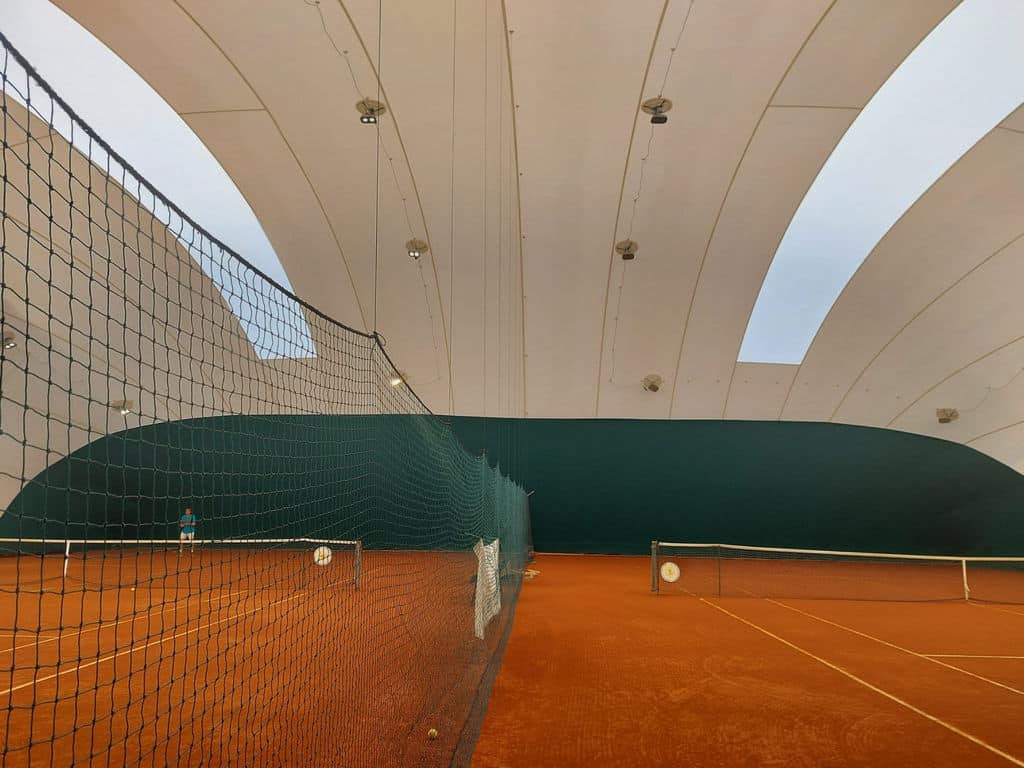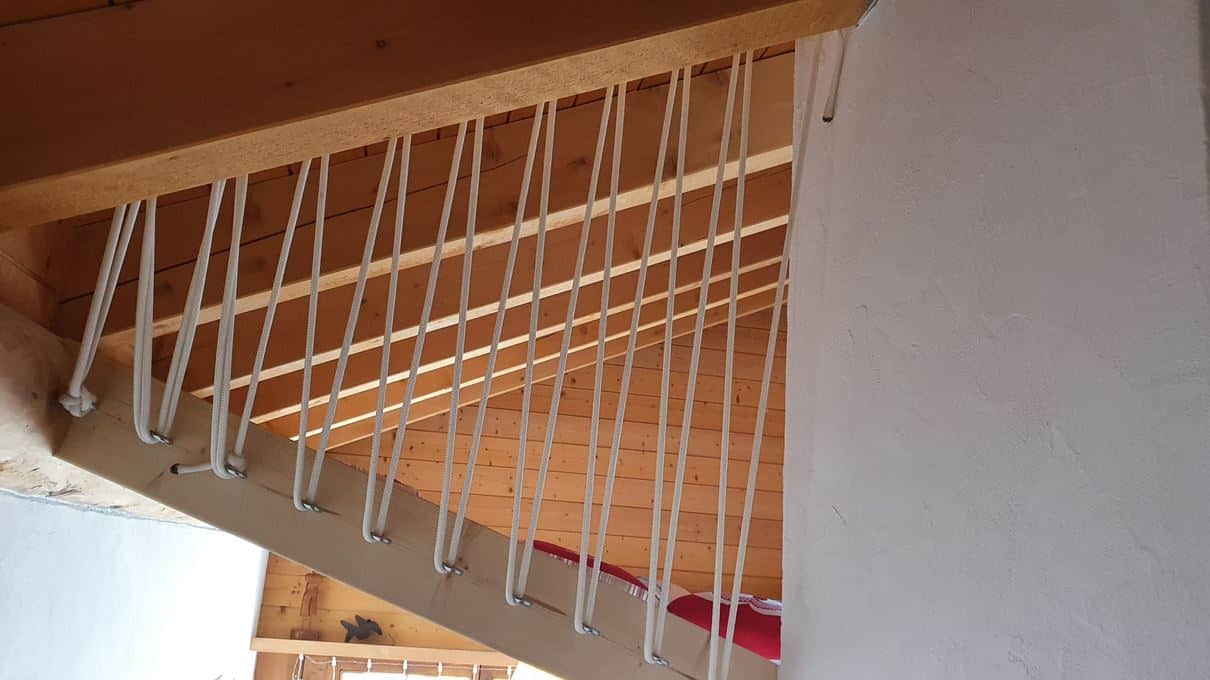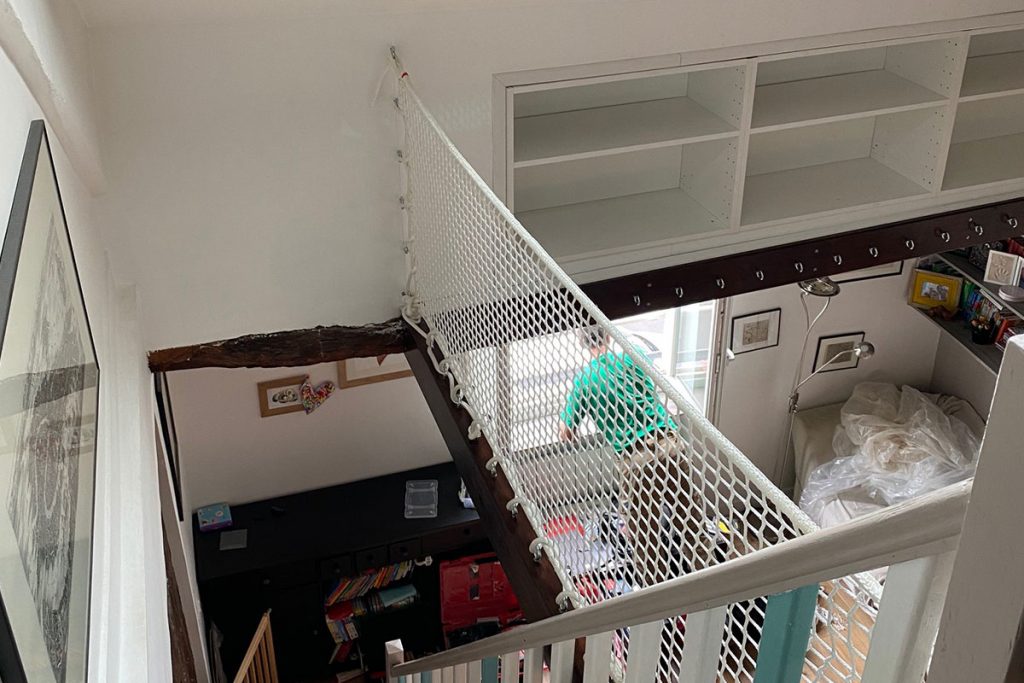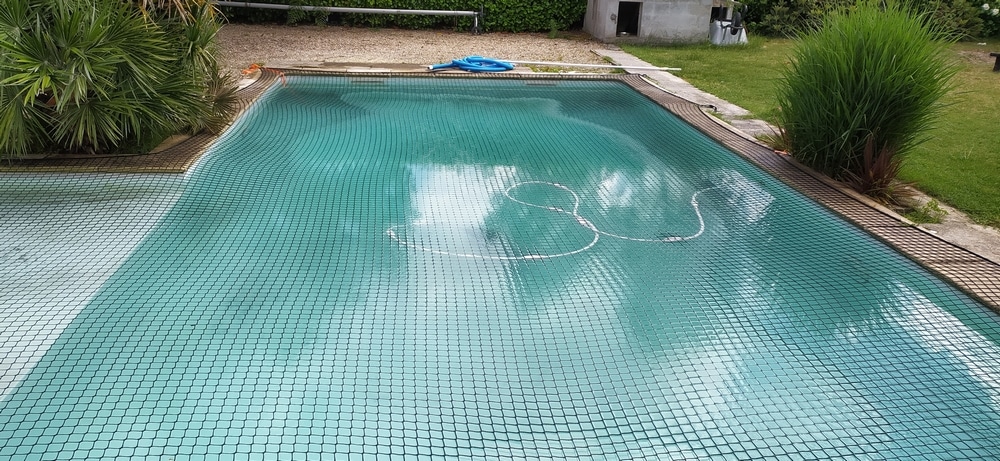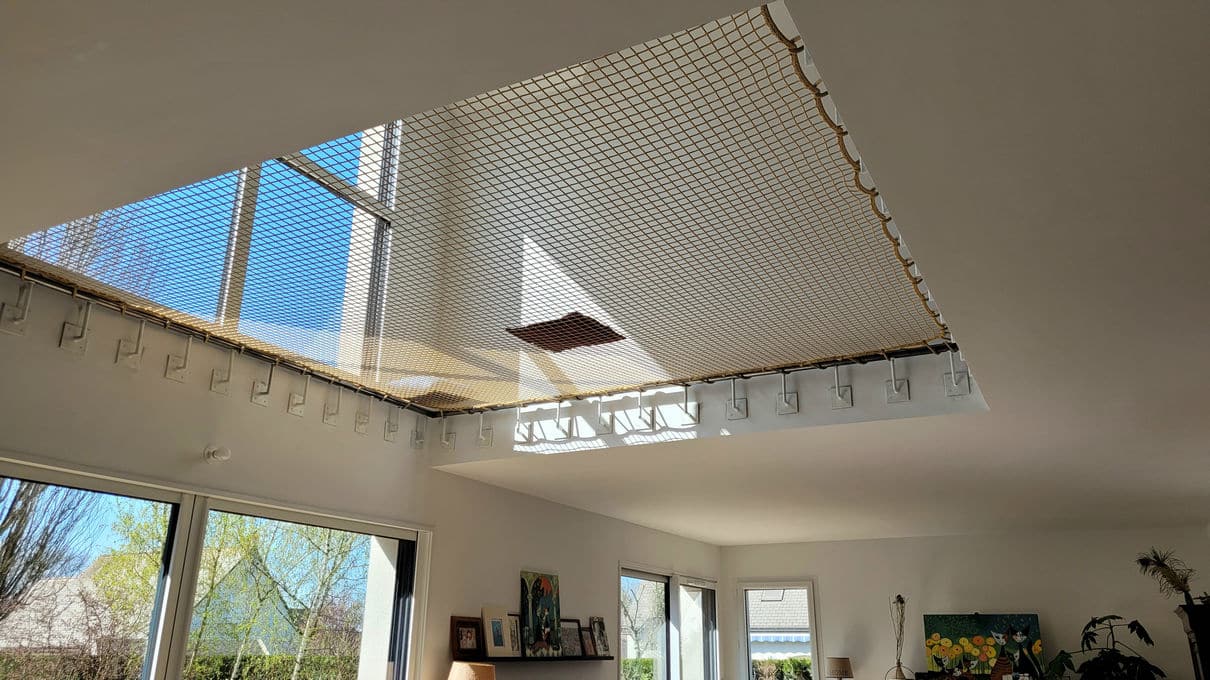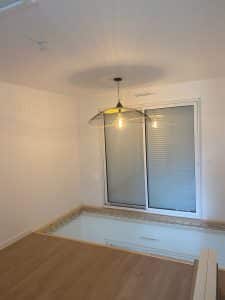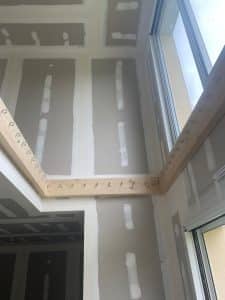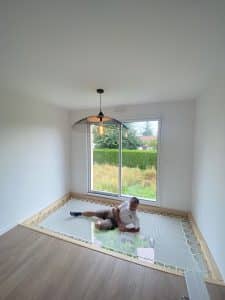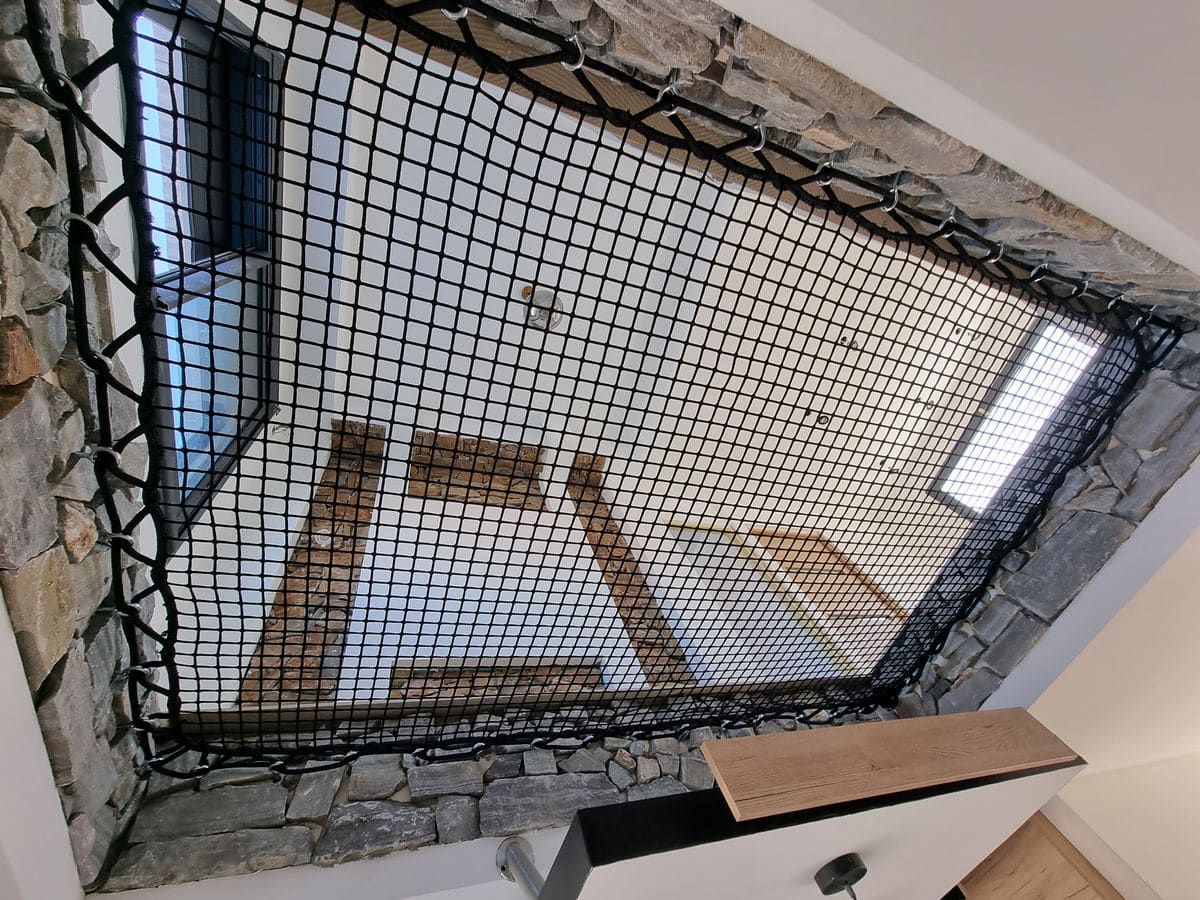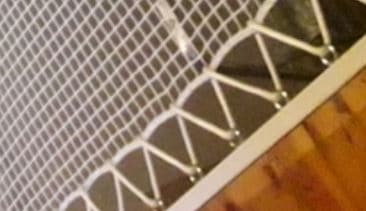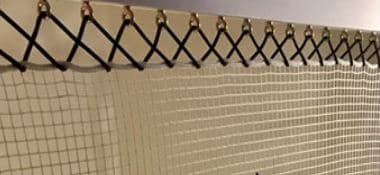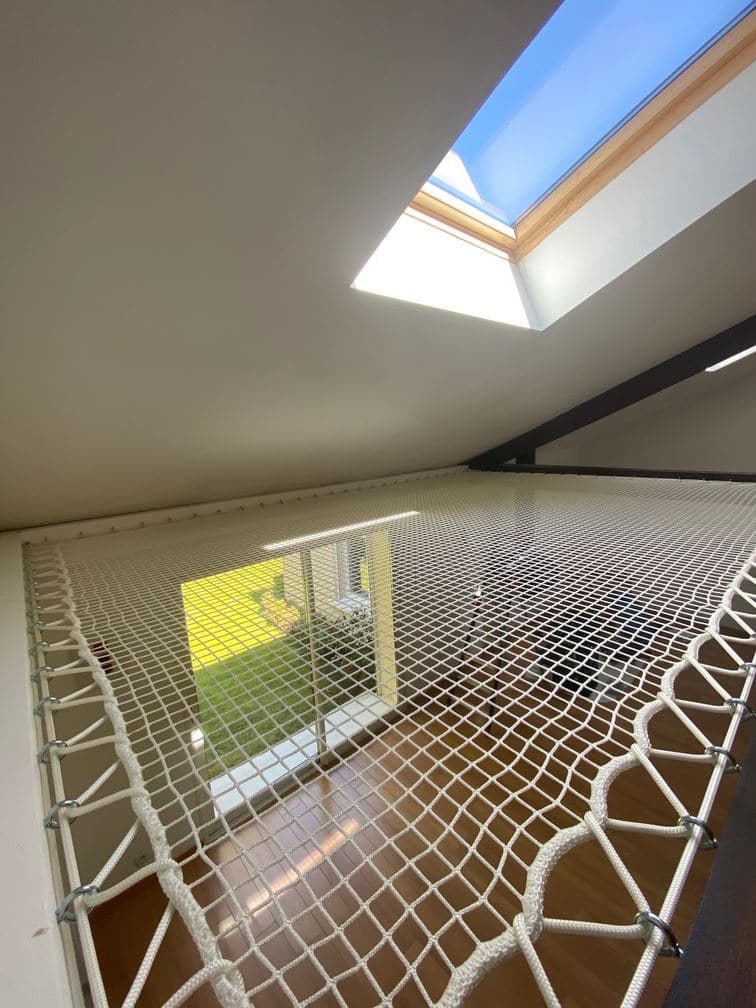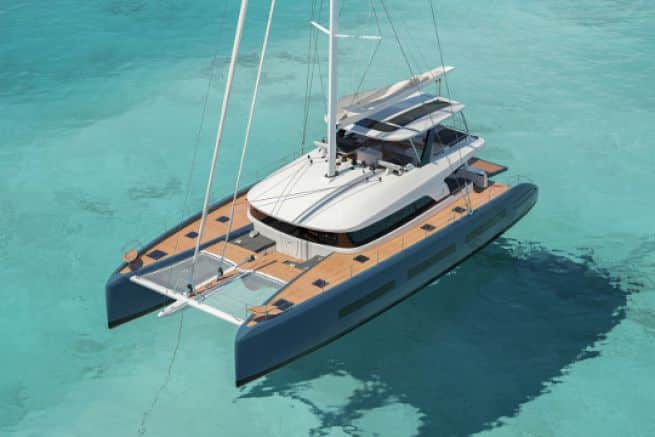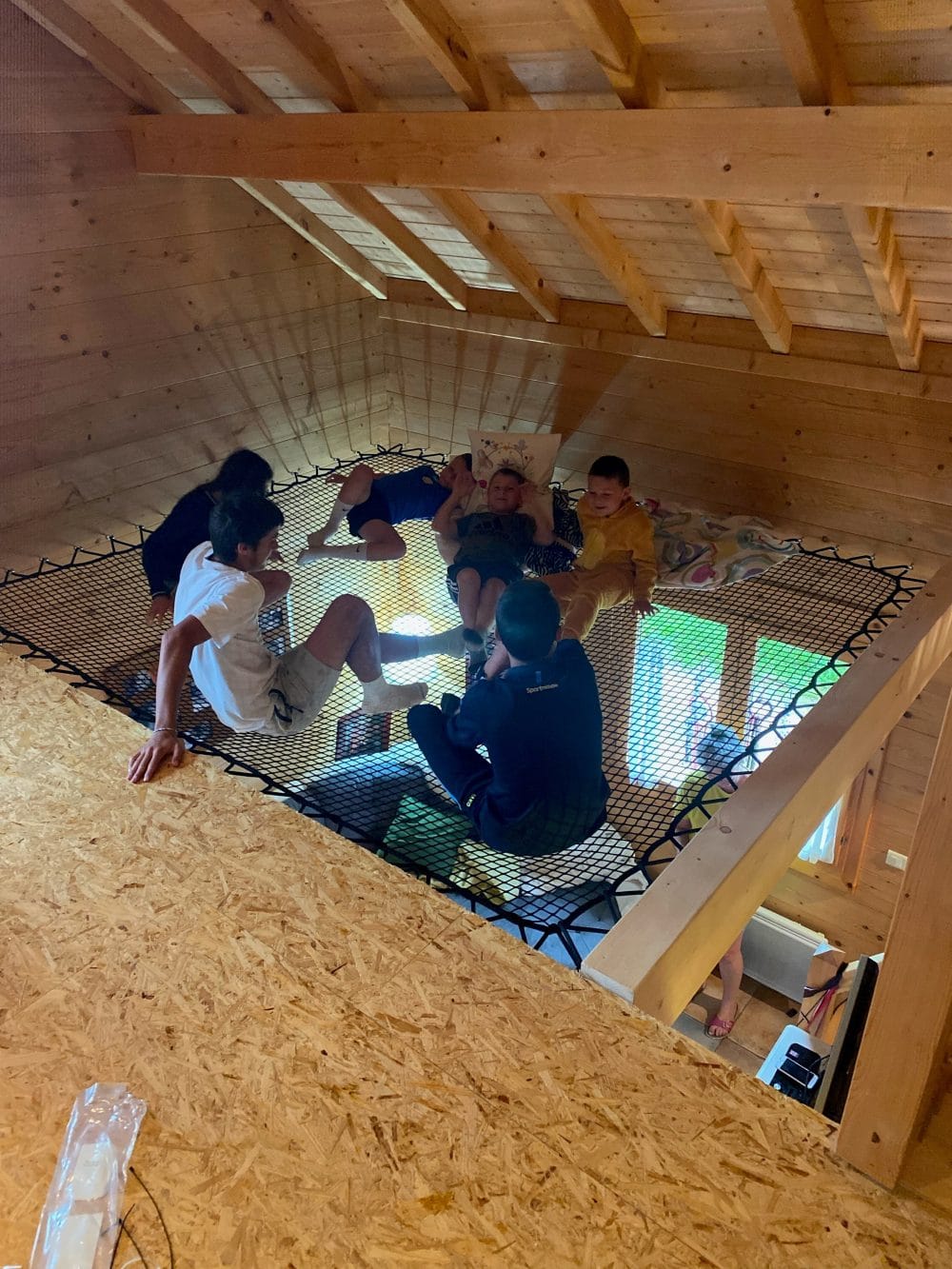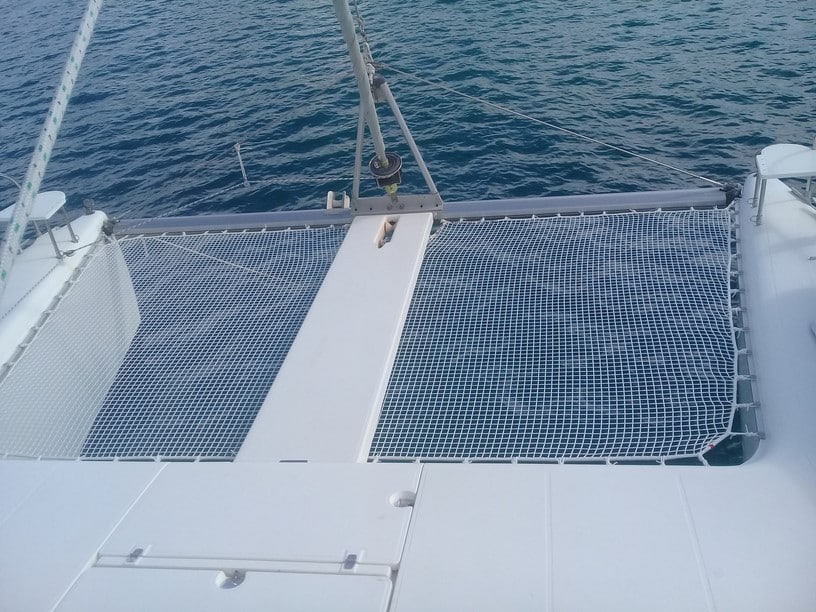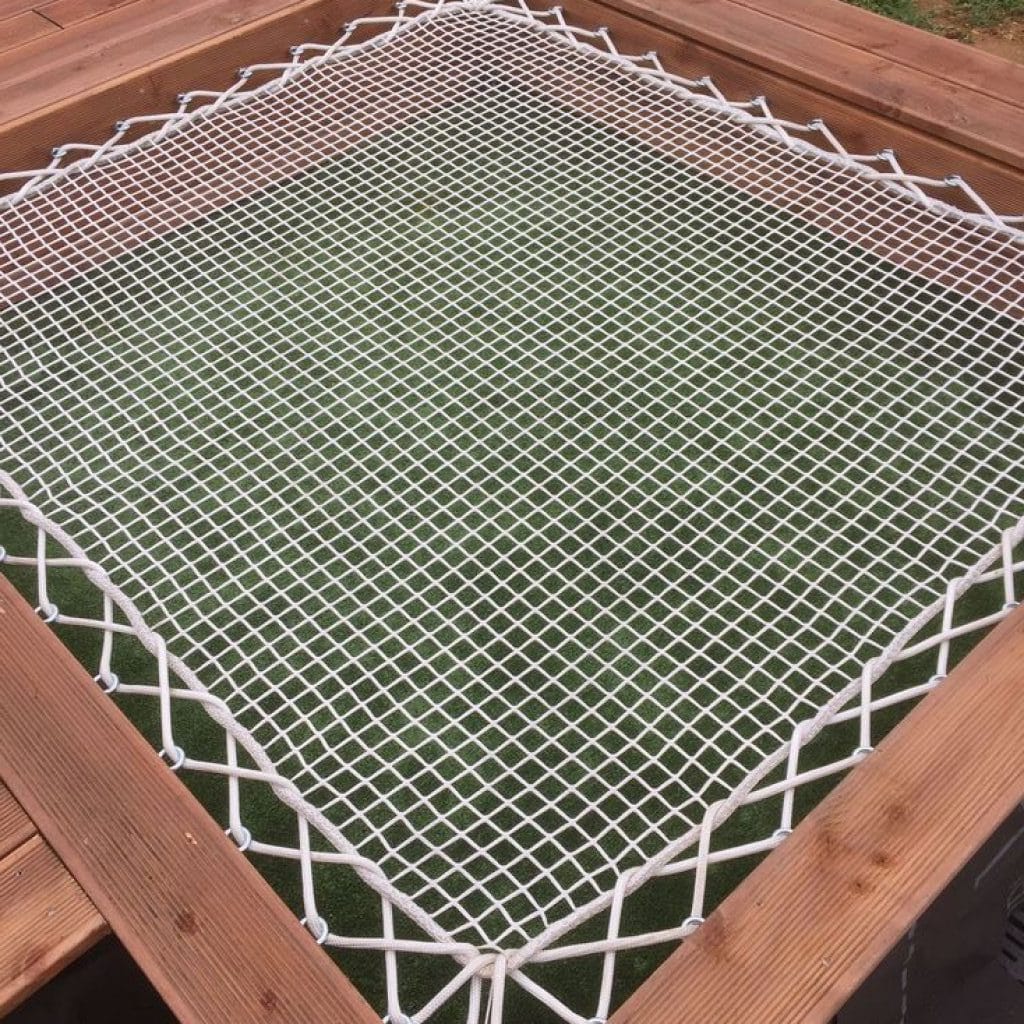Nets in Sports and Amusement Parks
Residential nets like those offered by Feelnets now have many other applications. These ultra-resistant nets, which can also be used outdoors, are also popular for sports uses or for increased safety in amusement parks (tree climbing, zip lines...).
Resistant and Elegant Sports Nets
In the world of sports, nets are used to separate a field into two parts or to materialize the inside of a goal area. Sports nets are used for basketball, volleyball, tennis, football, badminton, table tennis, golf, and other sports. They are generally made from wear-resistant synthetic fibers, such as nylon, and are designed to withstand outdoor conditions. Sports nets are available in a variety of sizes and colors, and their installation may require the use of a specific fastening system. Some nets are designed for temporary installations, offering a flexible solution adaptable to various needs, while others are designed for permanent installation.
Do You Know the Different Types of Sports Nets?
1. The Separation Net
This net is used in racket sports such as tennis, table tennis, badminton, and padel or similar games (real tennis, beach volleyball, beach tennis, volleyball...). They allow the playing area to be separated into two courts, and theoretically make contact between players impossible.
However, separation nets have specific sizes and heights depending on the sport. For example, did you know that in tennis and padel, the nets differ in size and height?
In padel, the net is lower, its center is 88 cm high, compared to 92 cm in tennis. At its extremities, the padel net measures 92 cm, while in tennis, it reaches 107 cm. This lower net height in padel favors attacking shots and volleys. This sport, which is only played in doubles, is indeed very fast and allows for multiple combinations between players and court elements, such as walls off which the ball can bounce.
The net is therefore an integral part of the game and its techniques and strategies.
2. The Goal Net
The goal net plays a crucial role in various team sports such as football, handball, water polo, and field hockey. Its main function is to delimit the back of the goal cage, thus bringing an essential dimension to the game.
In Handball, players must prevent the ball from leaving the playing area. The positioning of the goal, straddling the line, transforms the ball's entry into a symbolic crossing. The shot is taken 9 meters from the net. This is why the latter is equipped with a shock-absorbing net at the back which serves to prevent any rebound or immediate exit of the ball after crossing the goal line.
In football, the nets, firmly fixed to the ground and attached to the crossbar and posts down to the ground, skillfully prevent the ball from leaving the cage alone after entering it. Referees perform thorough checks before each match, ensuring the integrity of the nets. Speaking of precision, the term “small net” refers to the side part of the goal, emphasizing its strategic importance.
3. The High Sports Net
Its function is to receive the ball's point, as in basketball, horseball...
The basketball net is an important and mandatory element for competitive basketball practice. It's especially the accessory that allows seeing if the ball passes through the hoop properly.
Standard basketball nets must measure 45 cm long and 80 cm in circumference, with 60 mm mesh, they are of course open at the bottom. The basket height is 3.05 m, or ten feet in Anglo-Saxon measure, which corresponds roughly to the height of the railing to which the inventor of basketball, James Naismith, had fixed the original baskets.
4. Protection Nets
In the context of sports, the sports net can also be used as a safety net to delineate the field. These safety nets are generally made of very resistant materials, such as polypropylene, nylon, and polyester, which can withstand significant loads and major impacts. Feelnets also creates custom protection nets for golf courses located near residential areas, which can also be used to secure the driving range.
Feelnets: Official Supplier of Sports Nets
Feelnets, specialist in residential and multihull nets, can provide you with Sports nets including the manufacturing of custom-made protection nets, placed behind or on the sides of fields. Our company is thus specialized in the production of all goal nets (Field hockey, football, handball, cricket...). We are able to supply you with nets of the right dimensions and standards, stable and easy to install for both indoor and outdoor use.
Nets for Adventure Parks, Amusement Parks and Tree-top Adventure: for Increased Safety
The tree-top adventure net is a safety net made of fabric that allows participants to have fun and challenge their limits in complete safety. Thanks to these protection nets, you can progress through a series of suspended platforms and obstacles with complete freedom. The nets are generally used in a variety of adventure parks, including tree-top adventure parks, playgrounds, and water parks. On this topic, you can consult our article Protective Nets for Child Safety: A Comprehensive Guide.
The nets are designed to be safe and durable to support the loads and movements of participants. The nets are usually made of nylon or polyester fabric, which is very strong and tough. The ropes that support it are generally made of stainless steel or galvanized steel for greater strength and durability. The nets can be installed at various heights to offer different levels of difficulty.
Custom-made Net: Uses You Hadn't Thought Of
When we think of “custom-made living net”, we inevitably think of a mezzanine net, above a living room for example. This is indeed the most common use in a house and for indoor use. But a custom-made net can be created for very different uses: railing for a mezzanine, a floor, a rope stair rail, a protective or anti-leaf net for swimming pools, for sports infrastructures... Feelnets, creators of custom-made nets, explains everything that can be done with these products that are as practical as they are design-oriented.
Create a Protected Interior with Custom-Made Nets: the Elegant Solution to Secure your Railing, your Staircase and your Open Spaces.
Beyond its aesthetic and practical function, the “living net can be used for purposes other than as a mezzanine net in a house. Of course, when there's a void to fill, the living net” proves to be an excellent choice.
But the custom-made net can have other uses in a house. For example, it can very well secure a railing indoors. Indeed, if you have an open mezzanine or floor, with a metal or wooden railing that runs along this space overlooking the void, you can increase its safety by adding a taut living net. This will completely fill the gaps in the railing and thus prevent any falls.
The same assurance of better safety in the context of a staircase guardrail. It is indeed possible to stretch a living net vertically along a staircase to prevent falls. This safety net for stairs is particularly recommended for young children.
For your outdoor terrace, opt for our protective net, stretched along the guardrail. You thus guarantee compliance with the strictest safety standards while eliminating any risk of accident. Our solution also preserves the light and design aspect of your terrace, adding a touch of elegance to your outdoor space.
In the Garden, the Custom-Made Net Protects the Pool from Accidents and Falling Leaves
As we have seen, a custom-made living net can also adopt the function of protective net, both indoors and outdoors. Happy pool owners already know this. Indeed, some have swapped the unaesthetic pool shutters and covers for nets stretched horizontally. By choosing a custom-made net with small meshes (we offer 30 × 30 mm or 50 x 50 mm meshes for this purpose) , your custom-made net will effectively prevent falls into the pool. You thus ensure the safety of young children or those who cannot swim and will prevent your pets from being trapped there, unable to climb back up...
Another very useful feature for pools: leaf protection. Indeed, the custom-made pool net will (in 13 × 13 mm mesh for example) prevent any leaves from settling on the water. Very decorative, this horizontally placed net allows you to continue seeing the pool water while protecting it.
And all Feelnets net materials are resistant to weather and elements, perfectly adapted for outdoor use, as they are UV-treated, fire-retardant and waterproofed.
Outside the Home, the Net Can Equip Sports Facilities or Horse Stables
The custom-made net can go beyond the house and garden to equip other spaces, less “private”. Indeed, these nets are also used in horse stables to create hay nets for horses. Our polyester hay nets thus allow the creation of knot-free nets, for maximum comfort for the horses and simplifying the handling of the net for the user.
Another original use: custom-made nets for sports equipment such as golf courses. To protect golf courses and best delineate spaces, we offer knotless Polyethylene nets with a 25x25mm mesh spacing. Attentive to details, these nets are available in dark green (recommended color for the net to blend into the landscape and be as discreet as possible).
Custom-made nets can also be used for goal nets for field hockey, football, handball, cricket... Indeed, nets for all sports can be provided as custom-made nets.
Two main uses are then proposed for custom-made nets in sports halls and fields:
- Goal nets and sports practice nets (football goals, handball nets, volleyball nets, cricket or even American football)
- And sports protection nets can also be placed behind goals or on the sides of the hall, indoor or outdoor field, such as ball-stop nets.
—
Do you want more information about custom-made nets? Contact Feelnets!
Craftsmen: become a Feelnets partner for the installation of house nets
Feelnets residential hammock nets can be installed by customers, but it is often preferable to use the services of specialist craftsmen. Feelnets has developed a network of craftsmen throughout France and is always looking for new partners to meet the growing demand.
Workers, Traders…: why become a Feelnets partner?
In the article on “How to install a Mezzanine Net in a home”, Feelnets explains how to install a hammock net on its own. To assist customers who wish to install their hammock nets themselves, Feelnets provides installation instructions with each package. These instructions cover every step of the installation of the hammock net: how to install the fixings, how to centre the net in the space to be filled, tips for tensioning with the rope and knots for securing the net.
However, the vast majority of Feelnets customers prefer to leave the installation of their hammock net in the hands of experienced craftsmen. In order to meet the needs of its customers as closely as possible, Feelnets has therefore developed a network of partner craftsmen who can help with :
- create a framework
- install a framework
- attach the hammock net to any support
- install and tension the hammock net…
Thanks to its network of partners, Feelnets can intervene anywhere in France to carry out all installations. Its partners are carpenters, roofers and other craftsmen…
Feelnets is always on the lookout for new craftsmen to equip its customers in all regions of France.
In addition to the craftsmen partners, Feelets also uses customised hammock net representatives in every region of France, offering closer contact to its customers.
How to become a Feelnets partner? 
All Workers and tradesmen who wish to sell or install hammock nets can become partners of Feelnets.
Benefit from low prices as a professional and an image exchange through the mention of your website.
So don’t hesitate to contact Feelnets, the number one partner for craftsmen. A response is given within 3 hours to every quote sent, so that the craftsman can respond quickly to his customers.
What is the Right Price for a Mezzanine Net?
Whether for decorative desires or interior design needs, mezzanine nets are increasingly popular in French homes (and in many other countries). Faced with the growing range of mezzanine net products, how do you know which one to choose and at what price? Feelnets, a specialist in residential nets, gives you some tips to set the right price for your residential net.
The “Basic Elements” of your Mezzanine Net
Before considering the cost of your mezzanine net, it is essential to verify that the supplier you have chosen offers you the essential services.
The Quality of the Mezzanine Net Material
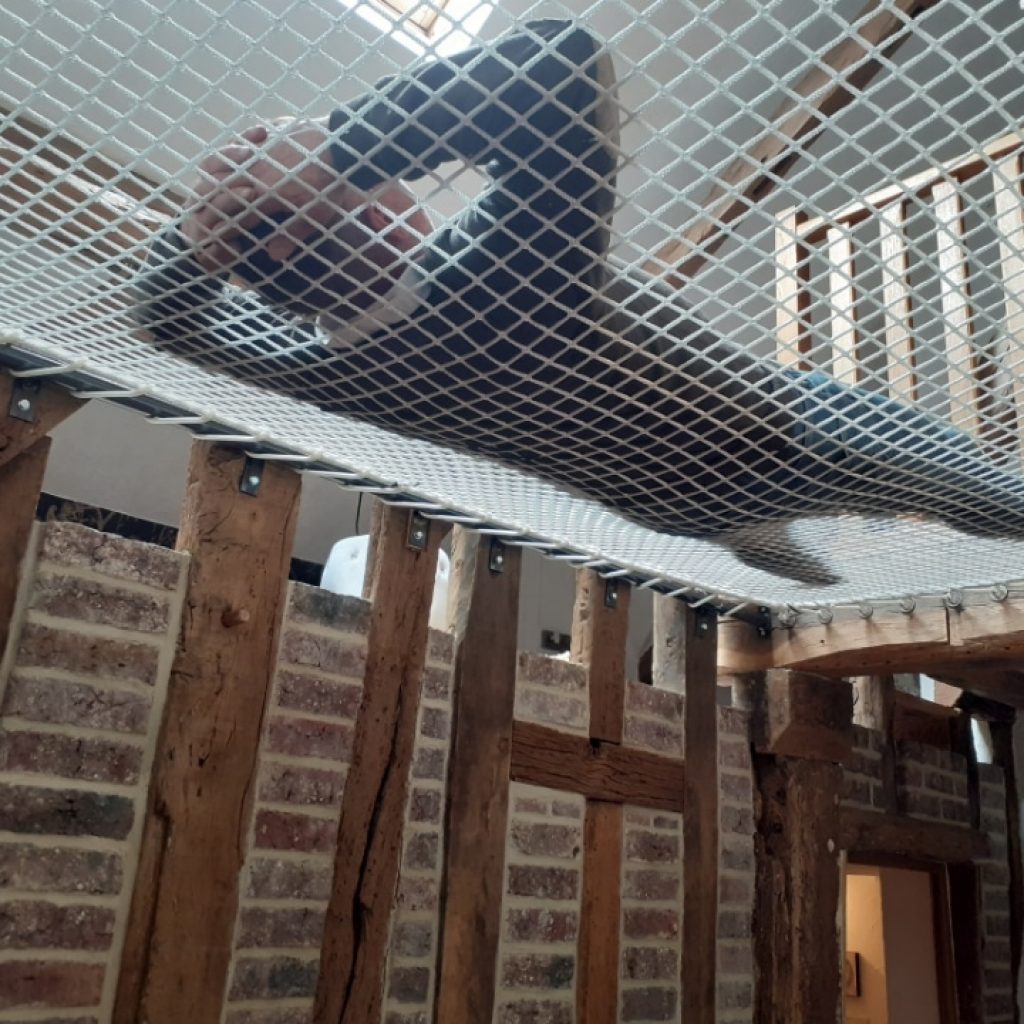
The mezzanine net is designed to bear the weight of several people (up to 5 adults, generally, depending on the surface). It is therefore absolutely necessary to ensure the high quality of the mezzanine net. At Feelnets, our mezzanine nets are very resistant and can support more than 200 kg / m².
Regarding the material chosen for your residential net, polyester (as for Feelnets residential nets) is certainly the best choice as it is the most resistant to time and various uses.
The Comfort of your Mezzanine Net
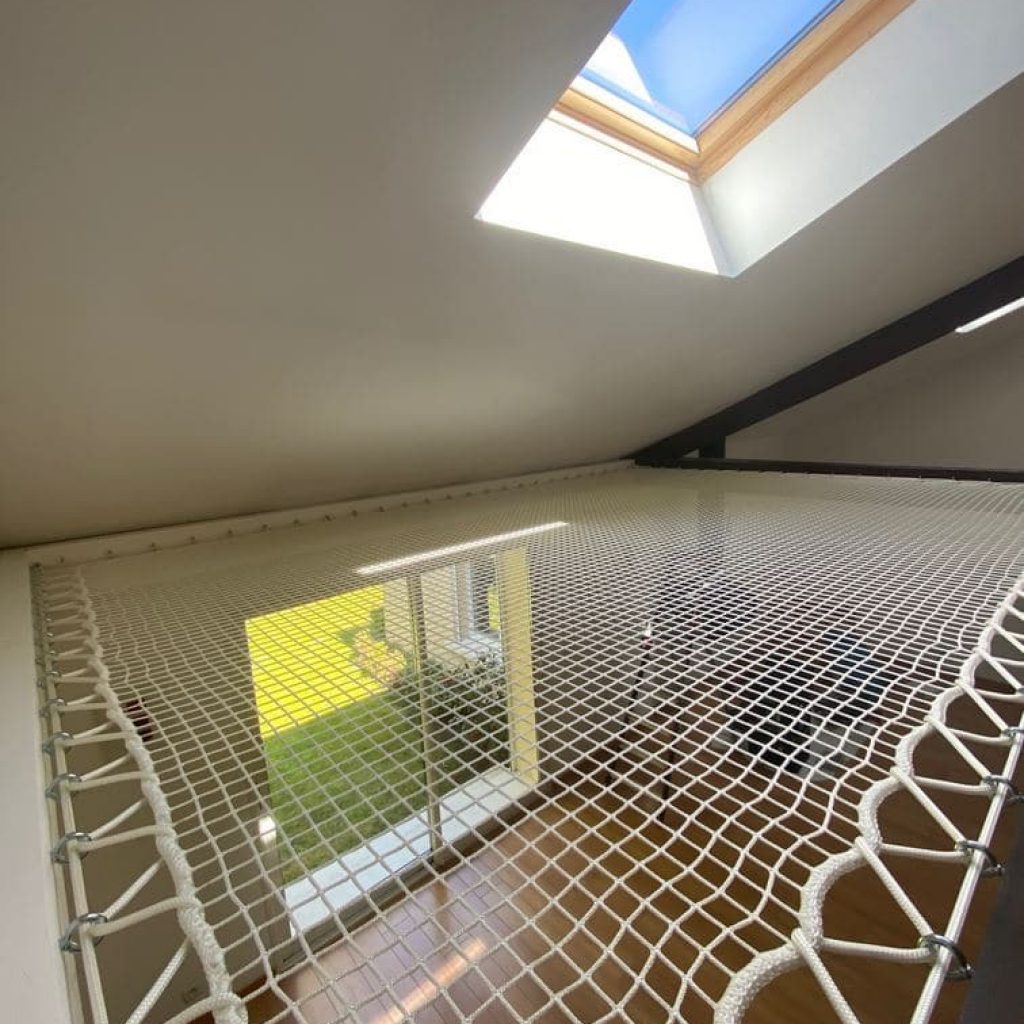
A mezzanine residential net must remain comfortable over time. It should not fray or risk cutting the skin when walking on it. By choosing polyester for our mezzanine nets, in braided mesh (therefore without knots), Feelnets ensures optimal comfort.
For your mezzanine nets to be installed above a void (such as for attic conversion with a mezzanine net, as explained in this article), we offer 30x30mm meshes, which allow light to pass through well, or 13x13mm meshes for less open but more comfortable meshes for children.
The Importance of the Strength of Fixings and Ropes
Another element of the utmost importance: the fixings and ropes of your residential net. Because if it proves to be resistant and comfortable, it still needs to hold perfectly on the frame you have chosen for it to transform it into a mezzanine net.
In order to properly tension your residential net, you must choose the strongest fixings, such as our galvanized steel eyebolts or our plate-mounted fairleads. As for the ropes for residential nets, multi-strand polyester is, once again, an excellent choice.
How to Establish the Right Price for your Mezzanine Net?
After ensuring the quality of the materials offered by your mezzanine residential net supplier, it is also important to consider the price. The right price is always the one you can afford.
Don't hesitate to make a comparison with equivalent materials, services, ropes, and fixings from other residential net suppliers. Depending on the number of fairleads needed, shipping costs and times, the quality of the products offered, the price per square meter, you can then make the choice that seems most appropriate to create the perfect custom mezzanine residential net for your home. Note that a custom residential net is a high-quality product, so its price is necessarily higher than a standardized mezzanine net with imposed dimensions.
Some Price Ideas for our Residential Nets:
Net in a wooden frame with 8*80mm eyebolt option
Dimension of the space to be filled 2500 x 2000 mm
30x30mm white mesh
65 x 8*80mm eyebolts (one eyebolt every 150mm)
23 meters of 10mm white tensioning rope (simple lacing)
For a total of €373.70 excluding tax / €448.44 including tax delivered in France.
That's €89.68 including tax/m²
Net in a wooden frame with plate-mounted fairleads with 4.5*50mm screws (black net with red rope)
Dimension of the space to be filled 2000 x 1800 mm
30x30mm black mesh
55 x fairleads with 4.5*50mm screws (one fairlead every 150mm)
38 meters of 10mm red tension rope (double lacing)
For a total of €462.30 excluding tax / €554.76 including tax, delivered in France.
That's €154.10 including tax per m²
Mezzanine Net in the Attic: Expand your House at Lower Cost (and with much less Work)
An extra room at a lower cost, without too much work, is an achievable dream thanks to the mezzanine net. Especially when you have a house with an attic and a high ceiling. Feelnets, specialist in indoor and outdoor nets, explains why and how to create a mezzanine with a net in your attic.
Why Create a Mezzanine in the Attic?
The answer to this question seems obvious: to create an extra room. But there are other benefits to creating a mezzanine in your attic: “utilizing” often wasted ceiling height, offering even more light to your living spaces, multiplying storage options, and creating a room that truly “communicates” with the rest of your house.
Using Lost Roof Height in your Attic by Creating a Mezzanine
Whether sloped or flat, your living room ceiling may have some “wasted” height that you don't know what to do with. To create a new living space, it's generally said that you need between 1.80 m and 2 m of height. If it's simply a sleeping area, a height of only 1.20 m may be sufficient.
To create a comfortable mezzanine for daily living in your attic, you also need to consider the floor space. A decent living space is considered to be from 9 m² upwards.
Offering Even more Light by Transforming your Attic into a Mezzanine
Attics are often “closed off” by nature. By deciding to create a new room in your attic, you will necessarily create a roof window, or even several. Thus, this “blind” space will be able to benefit from very pleasant natural light. And by opening this space to the room below as a mezzanine, you will be able to bring this additional light to your living room, kitchen, or entrance.
Creating Additional Storage
Whether you've decided to create a large or small mezzanine, the floor space can be used to create new storage. For example, you can create small closets on each side of the roof slope, running the entire length of the room. Or, if the walls are straight, install shelves that cover the entire wall surface.
Creating an Extra Room, Connected to the Rest of the House
The principle of a mezzanine (this “small platform built in a room with a high ceiling” according to Le Robert) is that it is almost always open on one of its sides to another room in the house. As a result, in addition to bringing more light to the room below, as we highlighted earlier, it allows you to stay connected to it. This is particularly useful for families, when this room is used, for example, as a playroom for children, who are then easier to supervise.
The Benefit of Choosing a Residential Net to Create a Mezzanine in the Attic
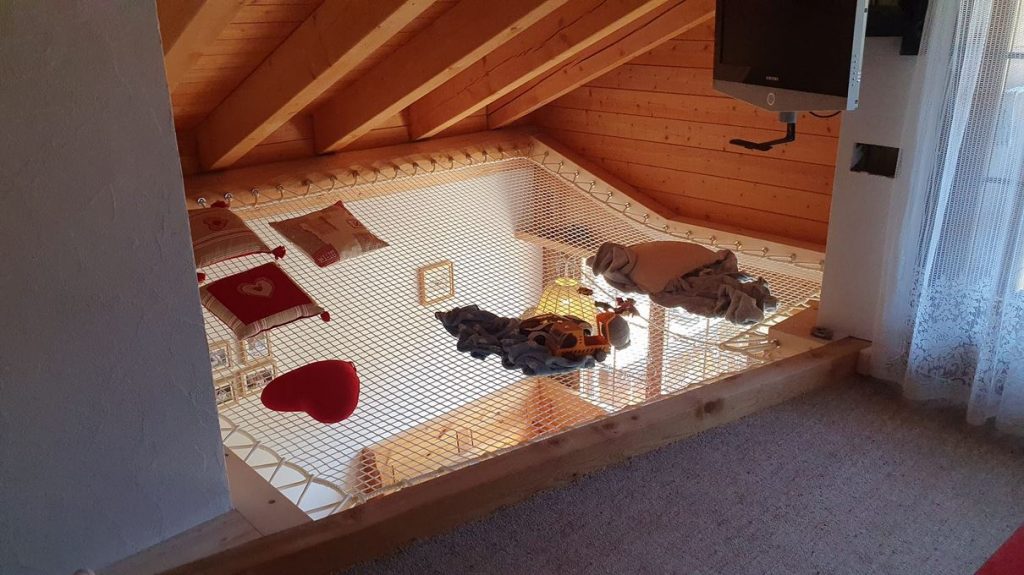
While creating “a mezzanine in your attic has multiple advantages, it becomes (almost) child's play when you decide to” install a residential net or, even better, to replace the entire floor with an indoor net.
Even more Light for Rooms under the Mezzanine with a Residential Net
As we've seen, a mezzanine brings new natural light to a living space. And this is even more true when this mezzanine is a residential net. Indeed, all of the light gained through the roof windows will be diffused to the room below the mezzanine, through the mesh of the residential net.
Thus, while offering a real design touch to your living room, for example, the mezzanine residential net will allow you to see even more clearly!
Create an Additional Multi-Purpose Room: Bedroom, Playroom, Home Theater...
When used to create a mezzanine, the living net offers a distinct advantage: it serves as both a “floor” and a relaxation space. This is not the case with a traditional floor. As we explained in our article on the different “uses” of a living net, a mezzanine net can become an additional play area for your children, but also a home cinema room (thanks to a projector) for young and old, a guest bedroom, or simply a relaxation space where it's pleasant to read and lounge on cushions. The mezzanine net requires nothing more to switch from one use to another...
The Mezzanine Net under your Attic: an Extra Room without Construction
Finally, choosing to install a mezzanine net rather than a fully solid mezzanine has two other advantages: lower cost and less construction work. As we “explained in our article on Why the mezzanine net is a good alternative to major renovations in your home, the only real requirement for installing a mezzanine net” indoors (as well as “outdoors) is to have” a solid framework. Then the “installation is so easy that some people try” it themselves. But if you prefer, Feelnets can direct you to its network of professionals for creating the “framework and installing your” living net.
--
Do you dream of a mezzanine net in your home? Contact Feelnets!
The 8 Reasons to Choose your Multihull and Outdoor Net from Feelnets
For over 15 years now, Feelnets has been providing nets and trampolines for multihulls and catamarans. While this experience is certainly one of the criteria when looking for a quality, durable, and strong multihull net, it's not the only one. Here are 5 reasons that will allow you to choose your catamaran trampoline from Feelnets with complete confidence.
Experience at the Service of the Best Net for your Multihull
For over 15 years, Feelnets has been supporting the world's largest boat rental companies in equipping their multihull nets or catamaran trampolines. The boat brands equipped by Feelnets with trampoline nets are prestigious and speak for themselves: Lagoon, Fountaine Pajot, Nautitech, Catana, Privilège, and Ocean Voyager...
The Feelnets Service for your Multihull Net
For boat owners or renters, Feelnets has a network of partners worldwide. They can receive your net if you can't be there to receive it yourself. Our partner receives your net and allows you to pick it up at their offices whenever you want.
Our other services that will delight demanding boat owners and renters:
- Your quote can be done in less than 3 hours
- We ensure delivery worldwide
- Our nets are custom-made
- The manufacturing time is 10 to 15 days
- Many models are often in stock such as the Lagoon 380, Lagoon 450, Athena 38, Belize 43...
Feelnets Guarantees for Boat Renters and Owners
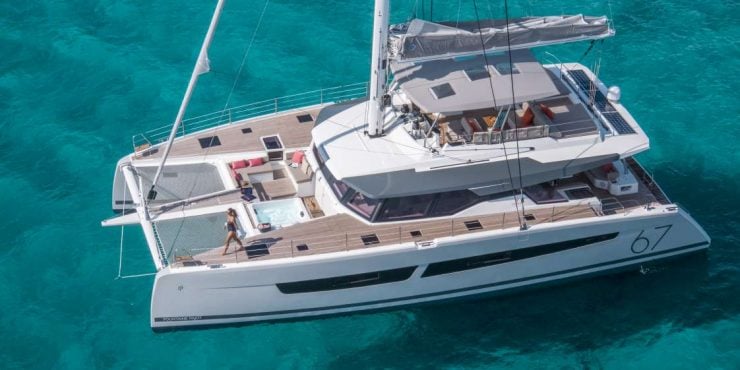
As Feelnets ships its multihull nets and catamaran trampolines worldwide, our company uses real professionals for its international shipments: DHL, UPS, TNT, or Fedex.
A tracking number is sent to follow your package and our team of professionals is at your service to bring your project to fruition, as well as to answer all your questions.
Continuous Testing of our Multihull and Outdoor Net Products
Our nets are tested worldwide every day. Some telling examples: Dream Yacht, the world's number 1 boat charter company, has bases and boats in the most beautiful places in the world (Seychelles, Caribbean, Polynesia, Thailand, or New Caledonia) and is one of our best customers.
Our outdoor nets are also tested by our hotel partners: The Conrad in Bora Bora in Polynesia, the Misol in Indonesia, The Lodge in Panama, or the Sammer in Austria.
Quality Materials on all our Outdoor and Multihull Nets
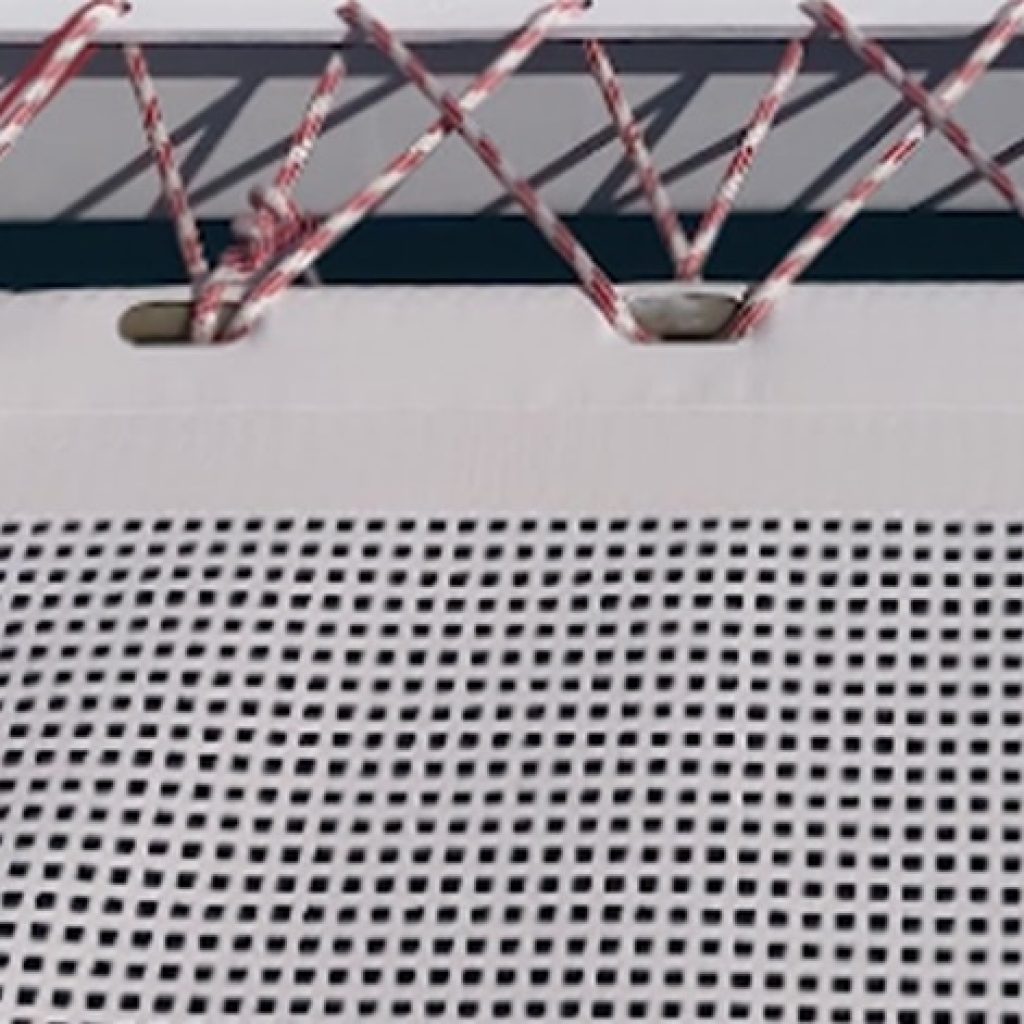
To meet all climatic constraints, Feelnets has selected the best-adapted materials for intensive and long-lasting use of our outdoor and multihull nets.
Polyester is undoubtedly the best-suited material to meet “all the constraints that a net can undergo (for reasons of climate resistance, intensive use, resistance to sea” water, sunscreen...).
The PVC mesh from Serge Ferrari (available in 492, 392 or 362) that we have chosen for our multihull nets, but also our outdoor terrace nets for hotels, is an excellent material, very resistant over time. The very high-quality finish offers perfectly aesthetically finished nets. These nets are therefore found on many “hotel terraces or on 60-foot multihulls for charters.
This material offers welded and sewn edges. Optionally, a finish is possible with eyelets all around; or with sheaths to pass a core through (we recommend the” sheath option for large surfaces).
A Feelnets Presence Worldwide
You can find Feelnets nets all around the world, whether on multihulls, catamarans, in hotels, playgrounds, forests, or even in homes.
Supplier to numerous hotels worldwide such as the Conrad in Bora-Bora, Feelnets extends the quality of its nets to more and more environments, always being recognized for the quality of its services and products.
The Trust of Shipyards for the Creation of Outdoor Nets, Multihulls, and more...
We are delighted to see, over the years, that more and more shipyards, among others, are trusting Feelnets for the manufacturing of their nets. We are currently a partner and manufacturer for HHcatamaran (China), Island Spirit (Thailand), Corthinx (Croatia), Pandora 8.50, among others...
This trust from our partners allows us to improve our products and to adapt even more to our clients' needs.
Our team of professionals can respond to all requests, don't hesitate to entrust us with your project and contact us: https://feelnets.com/contact/
Feelnets at the Highest Level of Multihull Nets and Catamaran Trampolines: Racing
It's only natural that Feelnets turned towards racing and became a partner and supplier in 2018 for the MOD70 Maserati skippered by Giovanni Soldini.
In 2021, it shattered 3 records:
- The Plymouth - La Rochelle record (12 hours, 15 minutes, 21 seconds),
- The Cowes-Dinard record (4 hours, 30 minutes, 49 seconds),
- And the Fastnet Maserati Multi 70 and Giovanni Soldini crossed the finish line of the original Fastnet course on May 8 at 19:14:11 GMT (21:14:11 Italian time), conquering a new record: 23 hours, 51 minutes and 16 seconds.
How Does the Mezzanine Net Give your Home a Little Holiday Feel?
A Residential Net on your Mezzanine for Even more Comfort in your Home
For many of us, holidays are synonymous with relaxation, well-being, and comfort. Unfortunately, these blessed moments only last for a while. But it's possible to give your interior a little holiday feel all year round. Through decoration, by bringing more light into your home, and the residential net can greatly help with this permanent vacation taste.
How?
A Net with Soft Materials
Contrary to what one might imagine, the residential net is created with solid materials that are quite soft to the touch. The materials that Feelnets uses for its indoor nets have been designed to be as comfortable as possible.
For example, our 30x30mm Polyester, available in white, gray, beige, or black, or 13x13mm (white or black) is a knotless braided mesh that allows you to lie down as if on a giant deckchair. Like a little bed of softness, your residential net is then an ode to relaxation and chill...
A Residential Net with a Soft Design
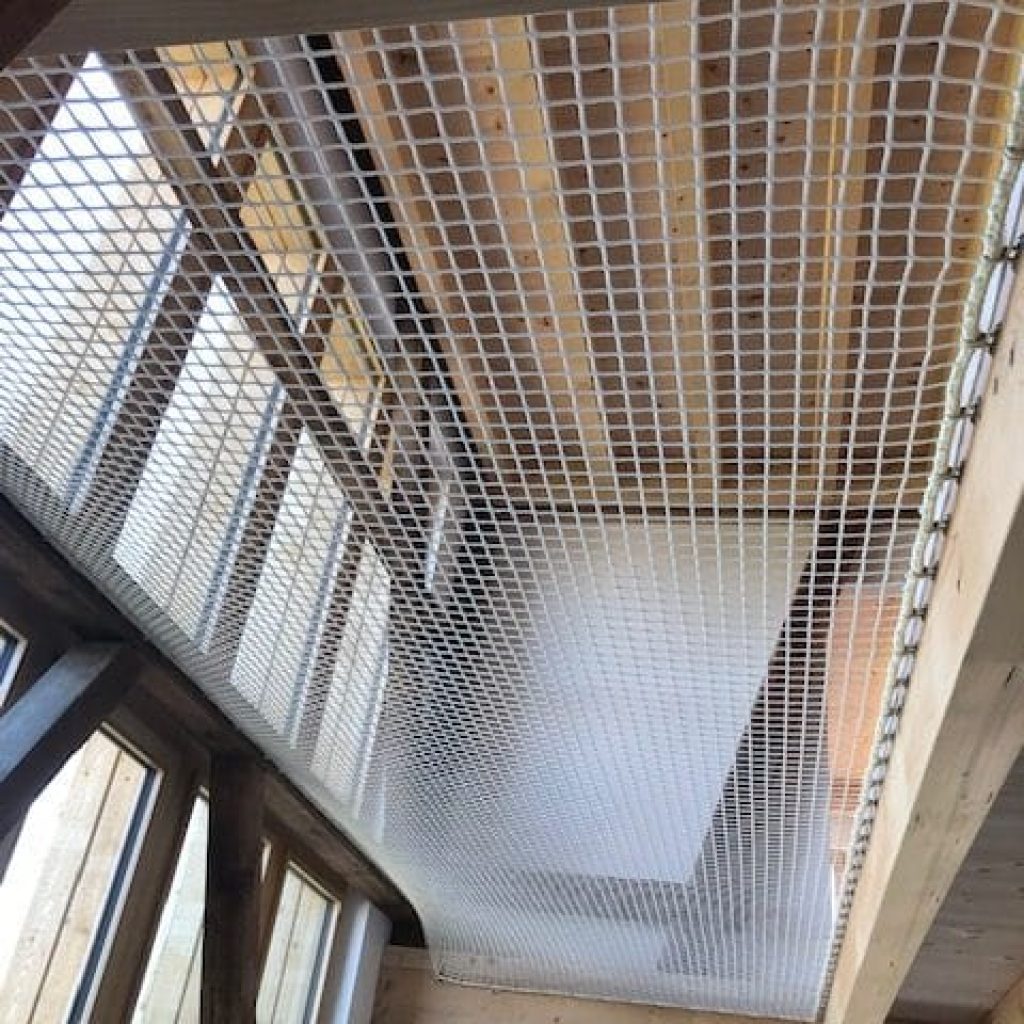
In mezzanine nets, it's not just the material that's soft, but also the visual aspect. Indeed, residential nets draw their origins from catamaran nets. These beautiful boats are often also synonymous with holidays and good times. More or less unconsciously, residential nets therefore offer a design that immediately soothes and makes you want to rest (or just settle down), to stroll...
A Residential Net on a Mezzanine for Even more Freedom
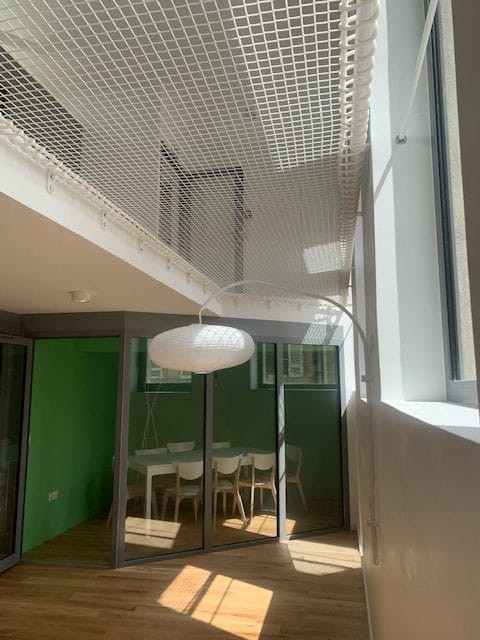
One of the small pleasures of holidays is this feeling of regained freedom compared to the rest of the year.
And we find this freedom in residential nets, in several respects. Inspired by the nets found on boats, the residential net therefore carries, from its origin, this air of freedom.
The residential net is also, by essence, an invitation to freedom. “Freedom to be settled wherever you want, to begin with. Indeed t”he custom residential nets like those offered by Feelnets only need “a solid frame to be set up. But they can be stretched indoors, outdoors, horizontally, vertically, and to the” dimensions you want.
A residential net “is also the freedom to let your children play, freely and safely, while keeping a watchful eye on them. Indeed, in”this article on Why the residential net “is a genius idea for children,” we explained to you that the youngest love to use indoor nets as an additional play space, which allows them to be close to their parents while playing as they wish.
Bring Light into your Home with a Mezzanine Net
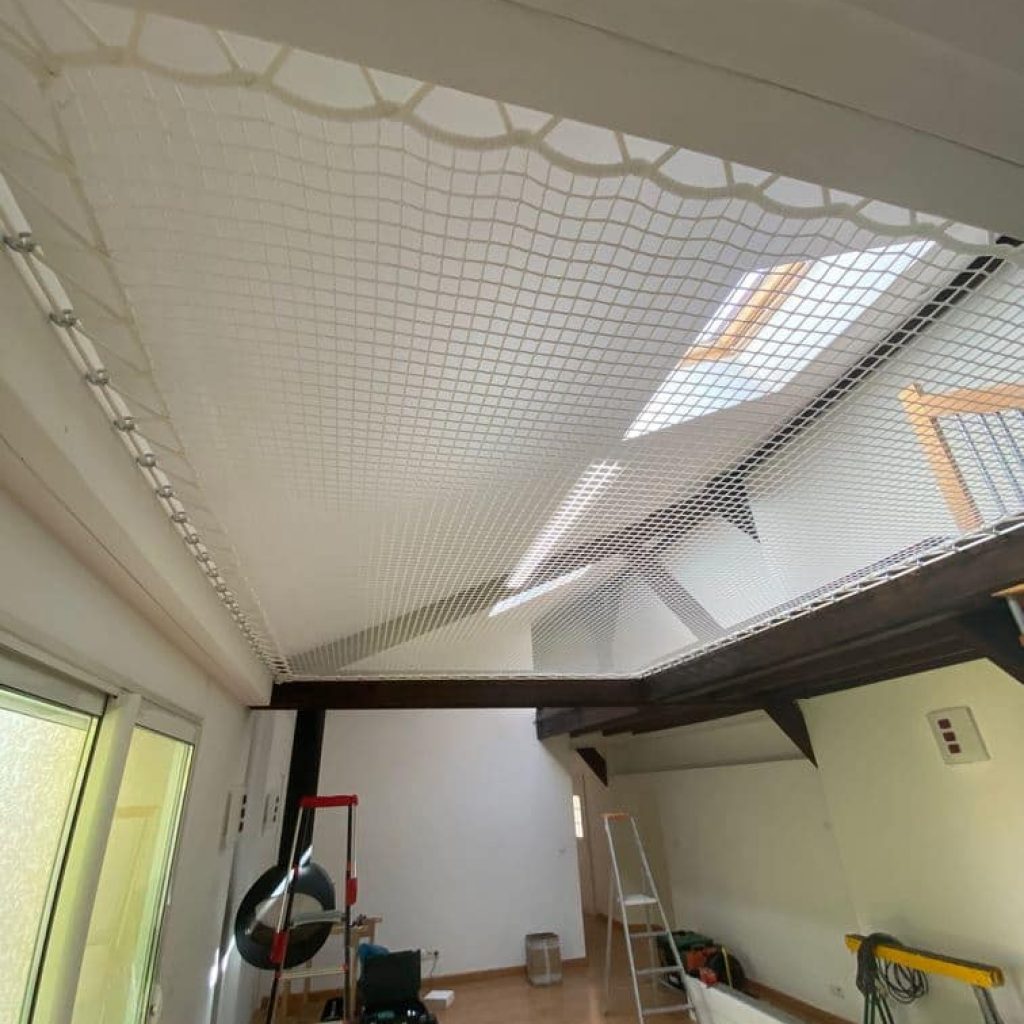
The other 'holiday' asset of the residential net lies in its structure itself. Composed simply of ropes, more or less fine and with a more or less tight mesh, the indoor net naturally lets in a lot of light.
Indeed, one of the great advantages of the residential net is its natural transparency. Unlike a wooden partition, a concrete wall, or a floor, the residential net will naturally let light through, while being able to support the weight of human beings and serve, for example, as a mezzanine over an empty space.
And, as explained in this Santé Magazine article on the effect of light on our health, this additional luminosity has positive biological effects on sleep, mood, memory, learning abilities, immunity... More light therefore makes you happier and offers relaxation to your daily life, close to that of holidays.
--
Want to install a residential net in your home? Contact us for any advice!
Why is the Mezzanine Net a Good Alternative to Major Renovations in your Home?
When living in a house, we often want changes. But we don't always have the courage to undertake major renovations. However, new interior design solutions now exist that are less expensive and often less constraining. The Mezzanine Net is one of them. Feelnets, your custom home net creator, explains why.
The Mezzanine Net: an Extra Room without any Renovations (or almost None)
Starting renovations in a living space when you're already settled is an operation one thinks twice about. Noise disturbances, dust, and frequent construction delays are all deterrents to a project of building an extra room in your house.
But rather than breaking or building walls or laying additional floors, why not use the space already present in your home? An unused hallway, a storage room, an attic, or simply an empty space surrounded by four walls can serve as a mezzanine. And to create a truly separate space, the custom home net is the ideal solution. Especially since you can (almost) install it yourself.
Installing a Solid Frame for your Mezzanine Net
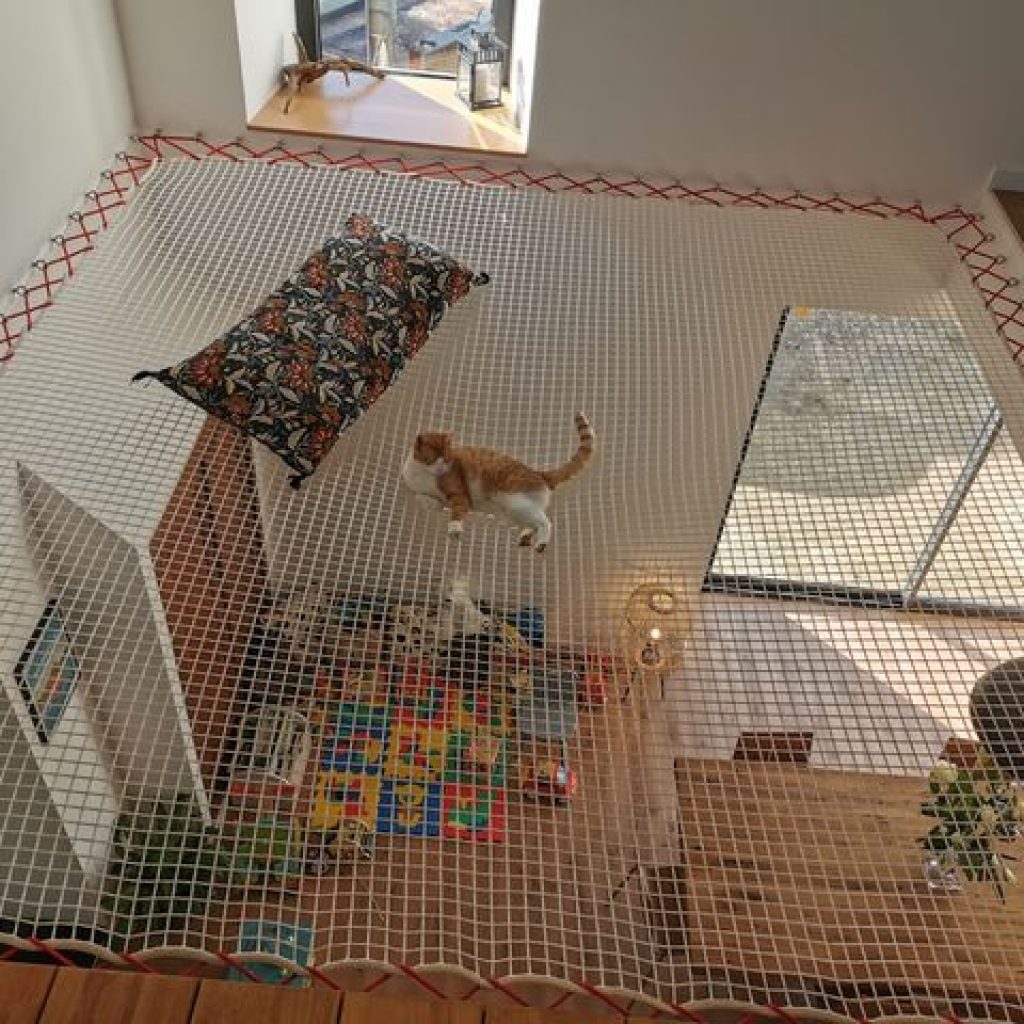
The only real requirement for installing a mezzanine net indoors (as well as outdoors) is “to have a solid frame. We have” dedicated an article to: In which frame can you install a custom net for living spaces? We explained there that the custom net cannot be fixed to plasterboard or other non-resistant walls.
However, you can install a mezzanine net:
- in a wooden frame (the simplest and most used solution)
- in concrete walls
- in I-beams
- with the passage of a chimney or stove flue
- in hollow bricks
- on walls with drywall and insulation
- between 3 walls and a staircase
- between two windows
For the installation of your frame, Feelnets recommends calling on professionals. Thanks to an experienced technical team, we accompany you through all the stages of your project. Our partners throughout France are also at your disposal to carry out the installation of your net.
Easy Installation of your Mezzanine Net

It is entirely possible to install a custom suspended net alone, even if, of course, it's easier with two people. But know that 96% of Feelnets customers install their net themselves. Why not you?
For this, you still need to know how to place aligned fixings all around, every 150 mm. We also offer a whole range of fixings for custom nets and we are here to advise you on the installation, whatever frame you have chosen.
You will then need to:
- Center the net in the space to be filled by attaching it at the corners and middles.
- Securely attach the corners with the right knots.
- Once the corners are attached, start lacing the sides using the tension cord.
- Check that you have achieved the ideal tension for your mezzanine net.
The Mezzanine Net: an Economical Solution to Create an Extra Room
In addition to being much less constraining than real major renovations to create an extra room, the custom mezzanine net is also much less expensive. To help give you an idea, Feelnets has provided you with some price ideas, even if custom work often requires a quote.
Attractive Prices and Rates for a Custom Feelnets Mezzanine Net
Here are two examples of mezzanine nets provided by Feelnets.
Net in Wooden Frame - Dimension of Space to be Filled 2500 X 2000 Mm
- With 8*80 mm eye bolt option
- 30x30 mm white mesh
- 65 x 8*80 mm eye bolts (one bolt every 150 mm)
- 23 meters of 10 mm white tension cord (simple lacing)
Total: 373.70 € excluding tax / 448.44 € including tax delivered in France.
That is 89.68€ including VAT/m²
Net in Wooden Frame - Size of Void to be Filled 2000 X 1800 Mm
- With flanged hooks on plate with 4.5*50 mm screws (black net with red rope)
- 30x30 mm black mesh
- 55 x flanged hooks with 4.5*50 mm screws (one hook every 150 mm)
- 38 meters of 10 mm red tension rope (double lacing)
Total: 462.30 € excluding VAT / 554.76 € including VAT delivered in France.
That is 154.10€ including VAT/m²
For any request for a quote or information on our custom-made residential nets, don't hesitate to contact us!
History of the Catamaran: from Polynesia to Speed Races
Whether for sport, beach, or leisure, the catamaran is a boat synonymous with freedom and speed, which continues to inspire dreams. Feelnets, your custom net creator, began its activity by creating nets for catamarans and other multihull trampolines and has established itself as a specialist in the field over the years. It therefore seemed interesting to us to look into the history of this boat, which is not as young as it looks...
What is a Catamaran?
Before we delve into the history of the catamaran, it seems important to define exactly what we're talking about.
A catamaran, according to the Larousse, "is ‘a sailboat or motorboat with two coupled hulls, used for pleasure boating.’ The two hulls are generally parallel to" one "another. These multihulls are therefore equipped with thin hulls that allow them to go faster by reducing water resistance (shallow draft), greatly increasing its stability and deck area."
Pleasure boats, they have also become highly prized sports competition boats (such as the famous America's Cup) and increasingly technical, present in many nautical races. Thanks to the “addition of foils, curved daggerboards as well as fins on the rudders, some catamarans can even fly above the” water.
The theoretical maximum speed of these boats is 100 km/h, but technological developments have recently allowed some catamarans (such as the one in the SailGP circuit in 2019) to exceed 50 knots.
The word catamaran is said to come from the Tamil word kattuamaran. Katta for tie and maram for wood. And this is where its history begins...
The History of the Catamaran (without Net) from the Bay of Bengal to the Indian Ocean, Passing through Polynesia
The first "trace" of a catamaran is found in the writings of the English pirate and adventurer William Dampier, in the 1690s. He is the very first European to describe a catamaran he saw sailing in the Bay of Bengal, in the Tamil Nadu region. He describes them in these words (source Wikipedia): "On the Coromandel coast, they call them catamarans. It is one or two logs, sometimes of light wood [...] so small, that it carries only one man whose legs and bottom are always in the water."
But it seems that it was in the Indian and Pacific Oceans that the first catamarans really came into being. Indeed, as highlighted in this fascinating article by Voiles et Voiliers on Oceanian canoes, the settlement of all these Oceanian islands was done by boat and would have started between 50,000 to 35,000 years before our era.
The map below shows 50,000 years of sailing migrations, made possible thanks to multihulls - catamarans, trimarans, praos. Indeed, Polynesians have always used a particular form of two-hulled boat called a “prao”. Its particularity: moving in both directions thanks to a 180° rotation of the sails.
Map @ François Chevalier
The Prao (Still without Net), Ancestor of the Catamaran?
An Indonesian multihull sailboat, the prao is a derivative of Indonesian outrigger canoes, which are also found in the Philippines in the form of a trimaran. Asymmetrical, it has a main hull and a float placed parallel and connected by connecting arms.
This boat appears very early in the drawings of European explorers. It can be found in the accounts of William Funnell on the Pacific Islands in 1705 or of George Anson on the Mariana Islands in 1743. And in 1711, Woodes Rogers even brought back a disassembled one to London, to exhibit it in St. James's Park.
To better visualize these “praos” and other craft, Voiles et Voiliers has published various drawings by François Chevalier such as the praos of the Mariana Islands, those of the Bismarck Archipelago or the catamaran of the Fiji Islands.
Sport Catamarans (with Net) that Keep Gaining Speed
In the Western world, catamarans were first built in England in 1662 by William Petty. However, it is the one nicknamed “the wizard of Bristol”, American Nathanael G. Herreshoff, who is often considered the true father of the catamaran in the West, particularly thanks to his technical marvels that allowed the catamaran to transition from pleasure boating to sport.
The man who invented the modern dinghy, keelboat, and catamaran – and won the America's Cup six times – was the first Westerner (read his portrait HERE), in 1870, to design and build catamarans of unprecedented speed and stability. In 1877, he created the 9.75-meter catamaran John Gilplin, whose plans (see below) are of extraordinary modernity. In the spring of 1891, he launched Gloriana, 21.50 meters long, the first pure racing sailboat.
Among other catamaran pioneers, we also find the “pati à vela” (sailing board), born in Catalonia in the 1920s. A rudderless catamaran highly appreciated by Spaniards, Dutch, and Germans. In 1968, the Hobie 14 by Californian Hobart ALTER, known as “Hobie”, was created, followed in 1970 by the Hobie 16.
These catamarans with asymmetrical banana-shaped hulls immediately experienced enormous success. And the Hobie 16 remains the most widely distributed catamaran in the world.
The History of the Catamaran Trampoline
“While there isn't really a” history of the catamaran trampoline, it seems that “it only appeared late in the” history of the catamaran. “It's probably on the Tornado that we” see the first catamaran trampoline, as “we” imagine it today “. In 1967, the IYRU (the name at the” time for the International Sailing Federation) launched a competition for Class B catamarans (2 crew members, 20 feet by 10, 21.80 square meters of sail area). And “it was the Tornado, designed by Rodney March the” previous year, that “won. The one that would remain an Olympic catamaran until” 2008 already had a trampoline.
Sailing enthusiasts, boat owners, manufacturers, or renters, call upon the expertise of over 15 years of Feelnets for its nets / trampolines for multihulls / catamarans.
The Outdoor/Terrace Living Net: Choosing the Right Materials, Weatherproof and Time-Resistant
The outdoor living net, especially on a terrace, is a perfect blend of safety and aesthetics. We talked about this in our article on the benefits of terrace nets. However, to ensure the longevity of your outdoor net, it's important to choose materials that can withstand the assaults of time and weather. Feelnets explains how to choose these materials wisely.
Choosing the Material for the Mesh of your Outdoor Living Net
It's crucial to choose the right mesh material when opting for an outdoor net, for your terrace or garden. Not all materials are equal in terms of weather resistance (rain, wind, snow, sun...).
The mesh must be both tear-resistant and weight-resistant (especially when you opt for a horizontally installed living net) but also maintain its quality under strong sunlight or rain. Thus, by choosing the right material, you can be sure to keep your living net for as long as possible.
The Main Materials for a Living Net
There are three main materials used by living net manufacturers. Each has its own specificities. Polypropylene is ideal for large nets. Polyamide, which tends to stretch a bit when left outside, is recommended for indoor use. And finally, polyester, which is very resistant and preferred for outdoor use. Generally, all these materials are treated to be UV-resistant, fire-retardant, and waterproof.
At Feelnets, we offer an even wider range of materials for our custom-made living or boat nets: polyester, polyethylene, polypropylene, or even dyneema. We also offer custom-made technical fabrics in PVC materials such as precontraint 492, 392, 362 or Batyline from Serge Ferrari.
Why Choose Polyester for your Outdoor and Terrace Net?
Polyester provides a flexible and very comfortable mesh. But most importantly, it's a material that resists (almost) everything.
Brief scientific explanation: polyester is short for synthetic artificial polymer, also called polyethylene terephthalate (PET). It is manufactured by mixing ethylene glycol and terephthalic acid. Polyester is therefore a plastic and thus possesses all the qualities of resistance.
Thermoplastic or heat-sensitive, polyester fibers are durable and resist many chemicals. They also resist shrinkage, stretching, wrinkles (thanks to their exceptional elasticity), abrasions... These fibers, both strong and light, dry very quickly. This is very practical for an outdoor net and can thus prevent mold.
Finally, thanks to all these advantages, polyester is a material that has a very long lifespan and ensures that you will keep your outdoor net for years.
Choosing Materials for the Fixing System of your Terrace Net
On your terrace or in your garden, whether it's for a guardrail, a protective pool net, or an outdoor net in "sun bed" mode, it's necessary to properly secure your net. Once you've chosen the support (steel, wood, concrete, but never plaster) on which you want to fix your outdoor net, you then need to choose the most resistant fixing accessories.
The fixing rope is a crucial element, as it must ensure the durability of your net's tension. At Feelnets, all our ropes are made of polyester multi-strand, 6mm, 8mm, and 10mm, in different colors. Our ropes are therefore highly resistant. Once placed in lacing around the entire perimeter of the net, they allow for the best possible tension over the entire surface.
The fasteners: you need to position the fasteners every 150 mm to achieve a good distribution of load and tension across the entire surface. Two types of fasteners are available depending on your walls.
You can choose between closed eye bolts made of galvanized steel or stainless steel (for outdoor use) to be screwed into wood or placed in a plug for solid material. The second option is to install stainless steel deck plates every 150 mm as well.
Our various professional fastening products ensure, through their durability, that you can best install your outdoor living net.


